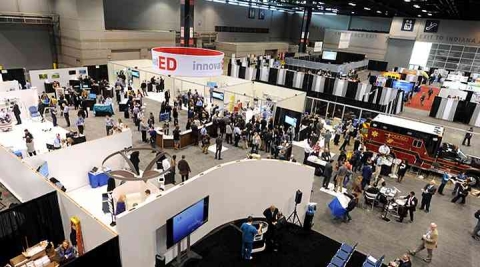Creating Disruptive Learning at Trade Shows and Events

In a society that’s more disconnected and lonely than ever, people no longer attend events because they just want basic information or random networking. Instead, they desire a strategically-designed experience where they can collaborate and create solutions to problems.
“People go to events for four primary reasons,” according to Marc Pomerleau, Global Strategy Vice President for FreemanXP. “They want to strengthen relationships, enhance competency, increase vision and perspective, and discover a sense of purpose.”
Creating the type of event that meets those needs can be tough because it requires a complete mental shift away from sharing ideas from the top down to a model that empowers the crowd, who already has access to the information.
At the American College of Emergency Physicians (ACEP), show organizers recognized that medical professionals wanted to cut through the show floor overwhelm and learn how to do their job better.
So, to create a more contextual experience, they created a simulated emergency room of the future, known as innovatED, where the entire process from ambulance through triage was included to make it as real as possible.
At pre-scheduled times each day, they conducted a Code Black with a shooting or other critical case.
TV monitors on the showfloor abruptly went black, then a fake newscast came on describing the crisis and showing video of the “live scene.”
Suddenly, the injured man on the screen was wheeled into the mock hospital, where ACEP members wearing microphones narrated their actions and demonstrated the featured tools. After the scenario, attendees could walk up and see all of the items that were used.
Initially, Robert Heard, executive director of ACEP, built innovatED by visiting medical facilities around the country to discover what they were using that was truly cutting edge. He then contacted those vendors about participating.
Now, after three years, there were more than 55 exhibitors in the space (which covers about a quarter of the showfloor), many of them new to ACEP and some of whom were major brands. Companies must now apply to be featured in the space, and a committee of physicians reviews and selects the most innovative.
The innovatED space allows medical professionals the opportunity to explore ways to make their facilities more effective.
It also offers long-time exhibitors a fresh way to interact with attendees, either through the daily Code simulations or 10-minute talks in the ED Talks Thought Leader Theater. And the concept also resulted in Heard winning the PCMA Innovation Award in 2014.
Reinventing events doesn’t mean a huge investment to entirely rebrand an event or hire an elaborate staging director. It does, however, require relinquishing control over the outcome of the event.
Pomerleau said it’s a three-step process: begin by disrupting complacency and see that the status quo is no longer an option, then envision what an amazing attendee experience will look like (not merely theater, but a substantive experience), and the final step is to figure out how to accomplish that vision.
Here are some other ways to disrupt and shift perspectives:
- Flip the learning pyramid like Freeman did at their Global Sales Meeting. When executives decided they didn’t want another from-the-top-down, talking-head event, they assembled a cross-section of employees to design an interactive alternative. Then they worked with Second City to develop customer service scenarios which were presented on stage at the meeting. Attendees were then assigned teams and entered the convention center where various zones were set up based on different aspects of the company. Each team had to respond to the challenges presented earlier on the stage. Teams visited the zones in any order to solve the problem, gaining layers of education and ah-ha’s at each stop, and leaving with a sense of accomplishment and understanding.
- Use science-fiction prototyping to build a full storyline that is completely outside the realm of current reality in the industry. Create comic books for attendees to use as a point of discussion, then post life-size copies of the comic book panels along a path for attendees to walk through and comment or evaluate. Show organizers then are able to collect data using that feedback.
- Create a wargame strategy using carefully-crafted personas which are bent on destroying the organization, such as hackers. This allows participants to bring up those “what if” thoughts which are typically considered taboo to address.
Trade show and event organizers also need to stop asking attendees if they were satisfied with the event.
“Satisfactory is a C, an average grade,” Pomerleau said. “Instead, they should be asking, ‘On a scale of 1-5, did our event fundamentally transform your view and understanding of the industry and your role in it?’ “


Add new comment